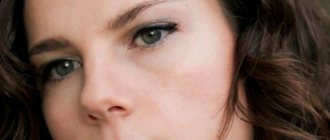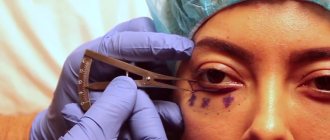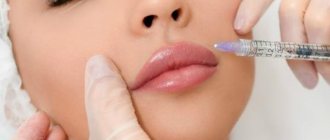The operation is completed. You woke up. Or you just felt that the doctor had stopped working his magic on you.
What's next?
I would like to say something like: and then they will treat you to tea, wish you a good day and send you home.
But I won't tell.
Because it's not that simple.
If everything went perfect. Your condition is stable and good. The doctor observes no signs of possible complications. You will actually be sent home in a few hours.
However, the rehabilitation period that began after the last knot on the thread requires you to be attentive to yourself and strictly follow the doctor’s recommendations.
This is what we will talk about today.
This is the first article of four dedicated to rehabilitation after blepharoplasty. The cycle of recovery after upper eyelid surgery begins.
Indications and contraindications for blepharoplasty
Despite the fact that every woman wants to look attractive, not every woman needs blepharoplasty to achieve the desired goal. The list of indications for this procedure is exhaustive: visible bags under the eyes, the appearance of excess skin in the area of the eyelids.
Directly on the lower eyelid you can see a layer of fat, which begins to bulge over the years - this is another unpleasant moment that can be eliminated through surgery.
The formation of facial wrinkles is an inevitable process, the result of cellular aging. And if small wrinkles sometimes give a woman a certain playfulness, then deep ones on the lower or upper eyelid are their complete opposite.
If you don't like deep wrinkles, then you can consider blepharoplasty as a solution to this problem. In addition to the above, indications for eyelid lifting surgery include drooping of the lower corner of the eye, sagging skin, and even a tired appearance.
It is important to remember that any operation is a great stress for the human body, which is why a list of contraindications for the blepharoplasty procedure has been established:
- chronic liver diseases;
- problems with the heart and blood vessels;
- oncology;
- diabetes;
- malfunction of the thyroid gland;
- high blood and intraocular pressure.
The postoperative period can be unpredictable, especially if it concerns people whose bodies are weakened for various reasons. In view of this, surgery is completely contraindicated for people who have recently had a heart attack, as well as those suffering from hepatitis or AIDS. Blepharoplasty is contraindicated for people under 18 years of age, pregnant women, during lactation and menstruation.
Infectious and acute respiratory diseases can cause complications both in the postoperative period and before surgery, for this reason they must be completely eliminated before the scheduled intervention.
We recommend: What are the recommendations after blepharoplasty?
If a person has chronic diseases, you need to consult not only with the specialist who is responsible for the operation, but also obtain permission to perform it from the highly specialized specialists under whose supervision you are.
Complications due to physician error
Asymmetry of the eyelids
Asymmetry is a doctor's mistake. Sometimes the defect goes away on its own, in other cases additional surgical intervention is required. Formed due to overcorrection of the skin or improper suturing.
The doctor has removed too much tissue, so one eye may appear smaller than the other. The operation is inevitable.
Poor quality seams
Incorrect suture placement is not only an aesthetic defect, it leads to suture divergence.
Poor quality stitching material leads to rupture and infection. In such cases, re-suturing is required.
The infection occurs due to violations of sanitation standards and non-compliance with medical recommendations during the recovery period.
Folds on the eyelids
Skin folds are formed due to the removal of excess fat. The defect is removed by repeated surgery.
Complications after blepharoplasty
Any plastic surgery is associated with the risk of complications. In many situations, complications after blepharoplasty require only conservative treatment:
- lacrimation. High tear production is associated with soft tissue swelling, which leads to displacement of the tear ducts. No treatment required here. As soon as the swelling decreases, the lacrimation will go away on its own;
- dry conjunctivitis. Eyelid surgery may cause conjunctivitis, although this condition is not considered a direct consequence of surgery. To reduce pain in the eyes and moisturize the mucous membrane, you need to use special eye drops;
- inversion of the lower eyelid. This is a rare complication after blepharoplasty. Its cause may be failure to follow doctor's recommendations or excision of too much skin and subcutaneous tissue. Due to the deformation of the eyelid, the patient cannot close the palpebral fissure; an open area of sclera forms between the iris and the lower eyelid. Typically, inversion of the lower eyelid is accompanied by dry mucous membranes. An effective way to prevent this complication is gymnastics for the orbicularis oculi muscle. Gymnastics and therapeutic massage are used when the first symptoms of eyelid eversion occur, and surgical correction is indicated only when it is severe;
- double vision. This visual impairment is considered a temporary complication. This is caused by a disorder in the coordinated work of the oculomotor muscles. No special treatment is required here, just doing eye exercises is enough. The function of the visual analyzer is restored after 2-3 weeks;
- retrobulbar hematoma is an extremely rare but serious complication after eye surgery. The cause is bleeding behind the eyeball. Signs: pain, limited mobility, protrusion of the eyeball. If these symptoms occur, you should immediately consult an ophthalmologist.
Despite the large list of possible complications, in many situations the rehabilitation period is positive.
What can affect the rehabilitation period?
These conditions extend the rehabilitation period:
- passion for tobacco and alcohol;
- age from 45 years - tissues heal more slowly due to the physiological process - aging;
- genetically determined thick skin - in this case, the tissues heal more slowly.
In patients with oily skin, wounds heal faster, while in those with dry skin, the recovery time is delayed. Closely located vessels can affect the rehabilitation period.
The duration of recovery is influenced by the patient’s care of the operated area and compliance with recommendations. If a woman visits a solarium or sauna contrary to doctor’s orders, the period is significantly delayed. And improper care and touching the operated eyes with dirty hands leads to the development of infection, that is, rehabilitation is prolonged.
How to care for your eyelids after blepharoplasty?
Proper eyelid care after blepharoplasty accelerates the disappearance of edema and bruises. With its help, you can achieve the best results of plastic surgery and maintain them for as long as possible – 10 years. How to care for your eyelids?
We recommend: When can you drink alcohol after blepharoplasty?
The main rule after blepharoplasty is to avoid anything that puts stress on the eyes and eyelids. To eliminate swelling, you need to give up alcohol and smoking - in combination, these factors contribute to lymph stagnation and swelling of the eyelids. For this reason, you need to avoid salty foods - they retain water in the body, which leads to swelling. You need to sleep only on your back, and put a high pillow under your head.
You need to limit yourself in reading small print, working at the computer, watching TV for a long time, and wearing contact lenses. You should also avoid intense staring and bright light to avoid straining the eye muscles. Instead of contact lenses, you will have to wear glasses for 2-3 weeks. Also try not to tilt your head.
The second rule is to protect your eyes and eyelids from external influences. Do not go outside in windy weather; wear sunglasses. For this reason, avoid cosmetics and soaps. It is better to wash your face with chamomile decoction - it has an anti-inflammatory effect. Also avoid thermal radiation: saunas, baths.
Swelling after surgery will go away faster if you apply cold compresses to it. To prevent infection, you need to use antiseptics after surgery. But the main thing here is not to overdo it, so as not to cause skin irritation. After blepharoplasty, it is useful to do eye exercises, but in moderation so as not to overstrain your eyes.
Answers to basic questions
When are the stitches removed?
On the first day, the woman/man is under the supervision of nurses and a doctor for 1–3 hours. The sutures are removed after 4–7 days. It all depends on the depth of the cut.
Will scars be visible on the eyelids?
Sutures are placed as close to the eyelash line as possible. After lower blepharoplasty they are almost invisible. After the end of the recovery period, they completely resolve.
After upper eyelid surgery, the sutures are more noticeable. They won't disappear in a month. It should take 12 weeks for the color to completely smooth out and even out. If scars remain after 3 months, physical therapy is performed to remove them.
When can you wear makeup after blepharoplasty?
Cosmetics can be applied 14 days after surgery. To avoid allergic reactions, since the skin is very sensitive during this period, select hypoallergenic cosmetics. Choose products from reliable brands recommended by your doctor.
Cosmetics should be light and soft. It is strictly forbidden to apply to the crust covering the surface of the wound, or to areas of irritation.
How long does it take to fully recover after blepharoplasty?
Takes 10–12 weeks. Photos of rehabilitation by day with explanations below.
A person can go home on the first day after the procedure. Severe swelling appears above and below the eyes, which can spread to the nose and area around the eyes.
2–3 days after the cosmetic procedure the swelling is slightly less. Take antiseptic drops and perform eye exercises.
A preventive examination is carried out on days 4–5. Contact lenses can be used.
On day 5, hematomas and swelling begin to subside. The skin under the patches itches. But you shouldn’t touch your eyes with your hands, much less scratch them.
6-7 days - the sutures are removed. The eye swells a little. The cyanosis disappears. Some sutures are self-dissolving, you need to come to an appointment.
On the 10th day, hemorrhages resolve. It is allowed to use cosmetics if the stitches dissolve.
After 2 weeks, the effect of the operation is almost invisible. The stitches are coming through.
40–45 days - recovery comes to an end. The effect of surgery remains noticeable.
By the end of 3 months, the sutures are completely dissolved.
What are the restrictions after blepharoplasty?
Blepharoplasty is a type of plastic surgery to correct cosmetic imperfections. 90% of success depends on the correct behavior of patients, so the following restrictions should be adhered to:
- sleep in a reclining position to prevent swelling;
- do not lift heavy objects or do bended work;
- eat as usual, avoid alcohol, smoking and spicy foods;
- do not wet the seams too much;
- do not remove the adhesive bandages yourself and do not pull out the threads;
- drink less fluid;
- give up contact optics for several months;
- do not visit the solarium, sauna and steam room;
- limit the consumption of coffee and tea;
- Do not use medications without prior consultation.
How long will the effect of blepharoplasty last?
Surgery of the upper and lower eyelids is characterized by good and lasting results. The duration of the effect depends on lifestyle.
Plastic surgeons claim that the result lasts up to 10 years, but practice shows that the effect lasts up to 5 years.
How long after you can have repeat blepharoplasty?
Repeated surgery is permitted if there are contraindications. Plastic surgeons do not recommend doing blepharoplasty more than 3 times in a lifetime.
Repeated surgery is performed after 3–4 months, when the initial sutures have completely healed.
How to speed up rehabilitation?
On average, the rehabilitation period after blepharoplasty lasts 14-30 days and depends on the volume and type of surgery, as well as on the individual characteristics of the patient. Manual and physiotherapeutic procedures, taking medications and ointments will help speed up this process.
Never prescribe self-medication! This should be done by the doctor who performed the blepharoplasty. If you have questions or doubts, it is better to contact him or go for a consultation with a dermatologist.
We recommend: What care is needed after upper eyelid blepharoplasty?
Compliance with the regime, a balanced diet and proper care of the skin of the eyelids significantly speeds up the period of full recovery and reduces the risk of complications.
What can be done
Unfortunately, the only way to correct the situation is another surgical operation. During the procedure, the specialist’s task is to strengthen the ligamentous apparatus and reconstruct the missing tissues using a flap from the upper eyelid.
It is mandatory to diagnose the inflammatory picture of the pathology, and if necessary, drug treatment in the form of non-steroidal anti-inflammatory drugs is prescribed. The dryness of the sclera is regulated using artificial tear drops.
Do you want to avoid this problem for sure? Choose laser eyelid surgery. The method of eyelid correction using laser technology is aimed at achieving maximum results without complications. During such an operation, tissues are practically not injured, all movements down to microns are monitored on a computer, errors are excluded. Just 40 minutes in the plastic surgeon’s chair, a week of rehabilitation and no inconvenience in everyday life!
Medicines
The pain that appears after recovery from anesthesia is usually not severe. But if unpleasant sensations grow and interfere with life, it is better to eliminate them.
To do this you need to take the following medications:
- Paracetamol;
- Baralgin;
- Nise;
- MOMENT;
- Ketonal.
Decongestant therapy consists of taking potassium-sparing diuretics: Triampur, Veroshpiron, Hypothiazide. To prevent infection, you need to treat your eyelids with antiseptics - Furacilin or Chlorhexidine.
Furacilin
To eliminate colloidal scars, you need a step-by-step approach:
- First, a corticosteroid drug (Diprospan or Kenalog) is injected deep into the fibrous compaction, which makes the scar soft and accelerates resorption. Here it is wise to choose the exact dosage and depth of administration;
- Then, using a laser, the surface of the skin is leveled and the scar is painted over to match the color of the surrounding tissue. In this way, you can, if not remove the scar, then make it much invisible.
External remedies for scar healing
The pharmaceutical industry produces a range of creams and gels that actively affect epidermal cells, which can significantly reduce the severity of scars after operations. The Contratubeks gel, which is capable of dissolving rough tissue and smoothing scars, has earned a good assessment from experts. Doctors recommend using it as soon as the stitches are removed. In addition, you can use other external preparations:
- Dermatix gel - has a high softening effect, prevents tissue hardening, smoothes out uneven scars.
- Zeraderm accelerates recovery processes, improves blood flow, and nourishes skin cells with oxygen.
- Kelofibrase prevents inflammation of scars and normalizes the water balance of the skin.
- Scarguard – forming a protective film, retains moisture, prevents tissue from drying out, softens scars.
Consult with your doctor about the choice of external scar smoothing agent. Some components of creams and gels can cause allergies and irritation.
Local remedies
External remedies will help eliminate the unpleasant consequences of blepharoplasty. To combat hematomas at home, creams and ointments are most often used:
- Hydrocortisone;
- Traumeel S;
- Lyoton;
- Lokoid;
- Indovazin.
To make itching go away and wounds heal faster, use Blefarogel or Imoferase cream. To prevent fibrous tissue from growing and to get a soft and even scar, you need to use silicone-based ointments: Clearvin, Kelofibraza, Dermatix gel or Contractubex.
To relieve dryness, irritation and redness of the eyes, the following drops are used:
- Oksial;
- Katinorm;
- Innoxa;
- Artificial tear;
- Systane.
The solution should be applied to the inside of the lower eyelid, pulling it slightly to the side. Folk remedies are ideal for tissue regeneration, but they can only be used after the wound has completely healed.
To reduce swelling, you need to make a compress from raw potatoes, and rubbing with ice from sage or chamomile will not only restore attractiveness and youth to the look, but will also tighten the flabby skin under the eyes, smooth out wrinkles and folds.
YouTube responded with an error: The request cannot be completed because you have exceeded your quota.
Rate this article:
- Related Posts
- Why do you need eye exercises after blepharoplasty?
- What are the recommendations after blepharoplasty?
- When can you wear makeup after blepharoplasty?
- When can you drink alcohol after blepharoplasty?
- What eyelid cream is needed after blepharoplasty?
- When can you exercise after blepharoplasty?
Patient reviews:
Galina, 51 years old
After plastic surgery of the lower eyelid, my eyes became different, or rather, even more than my eyelids, but it looked like eyes. My face took on a comical expression, and I was terribly scared. After going to the doctor, it turned out that after blepharoplasty, I received a complication as a reward - a round eye. Moreover, the situation was so serious that a repeat operation was scheduled. The doctor at the clinic where I had the operation insisted that this was not his mistake, but that it just happened that way. So I went to another hospital, where the surgeon said that this was a clear mistake and everything needed to be redone. The repeated plastic surgery went well, the unpleasant consequence went away, and it cost me a lot of nerves and money. Therefore, I encourage women to undergo any plastic surgery when they are truly vital, or the face has completely lost its appearance.
Why do keloid scars form?
The appearance of keloid scars after blepharoplasty is a rare consequence of the operation. A negative symptom is formed due to excessive proliferation of connective tissues. The process of formation of a keloid scar looks like this:
- The appearance of dense areas of connective tissue in the 2nd week after surgery, accompanied by burning, pain and itching.
- Transformation of scar tissue into hard, raised areas with a smooth surface. At the site of the keloid scar, redness or paleness of the skin is noticeable.
- A sign of the formation of a keloid scar is an increase in the area of the suture compared to what it was immediately after the operation. Some patients experience growths above the scar.
Ointments and creams
External remedies will help get rid of unpleasant symptoms after surgery. Effective drugs for eliminating hematomas are:
- Indovazin;
- Traumeel S;
- Lyoton;
- Hydrocortisone;
- Lokoid
To eliminate itching and speed up healing, you can use Inferase or Blepharogel cream. To ensure that the scar after surgery is smooth and soft, and the fibrous tissue does not grow, you can use the following means:
- Contractubex;
- Kelofribase;
- Dermatix;
- Clearvin











